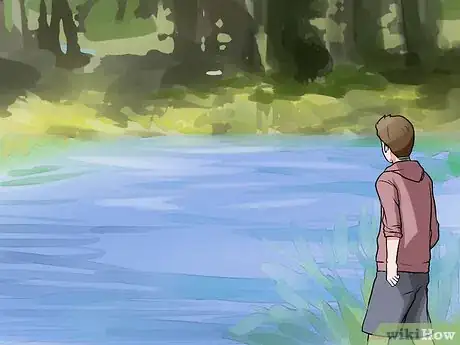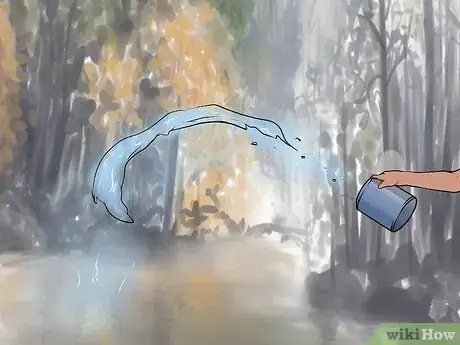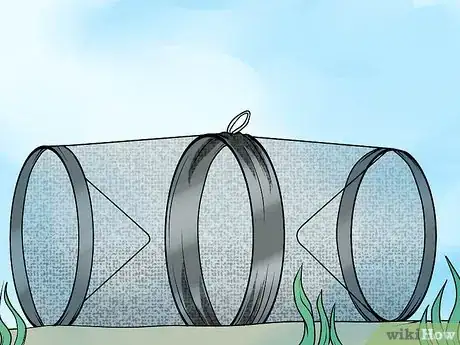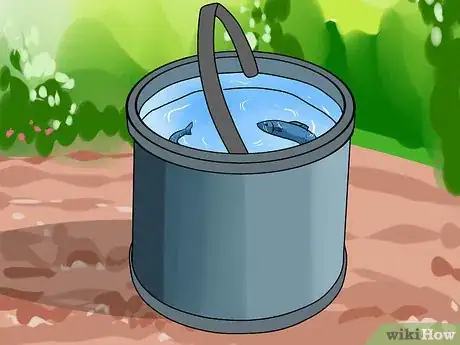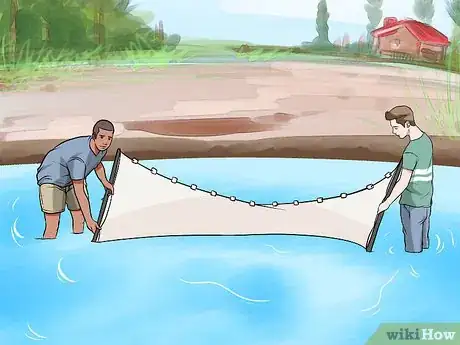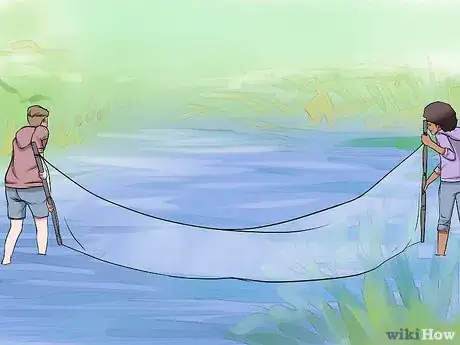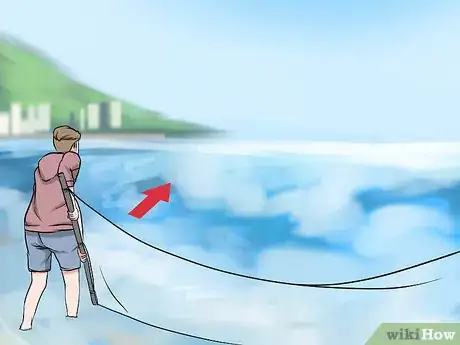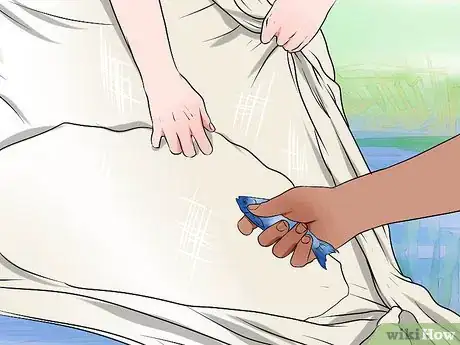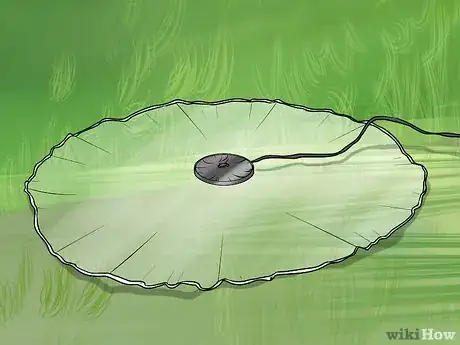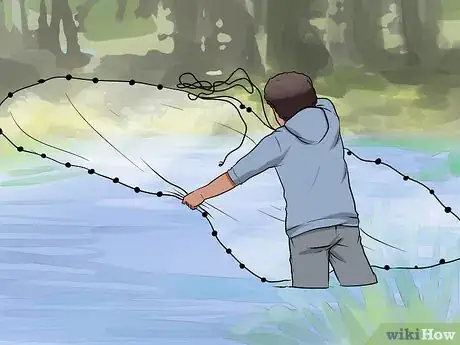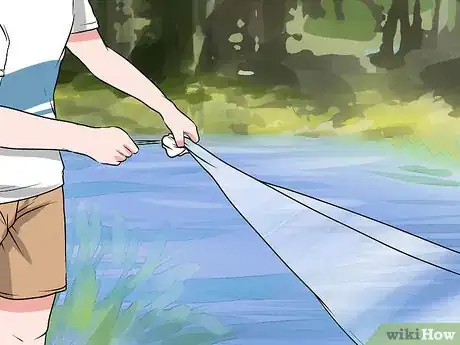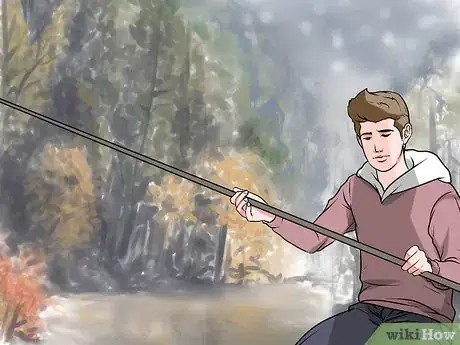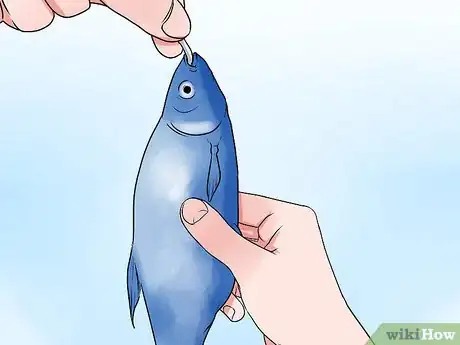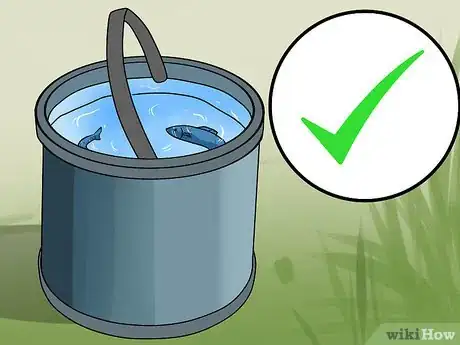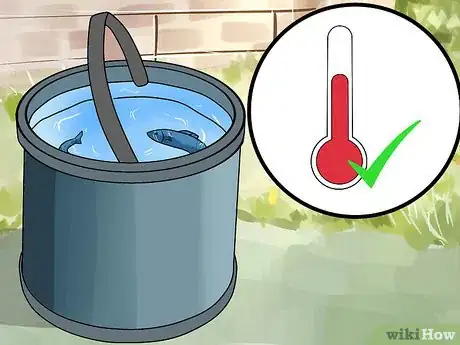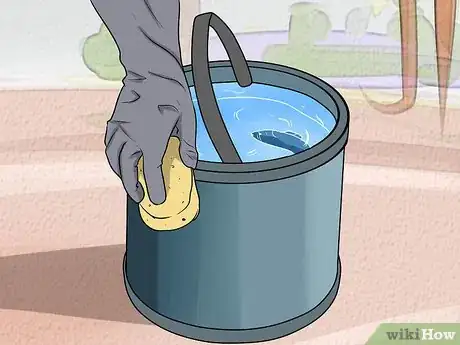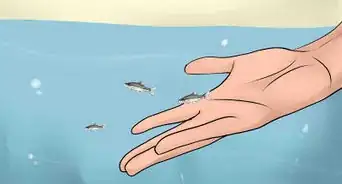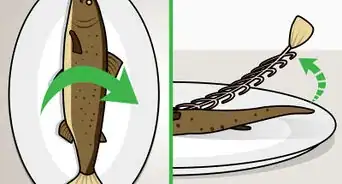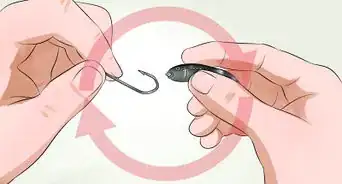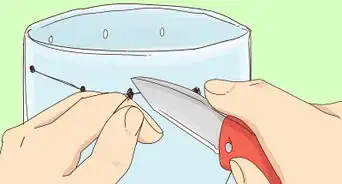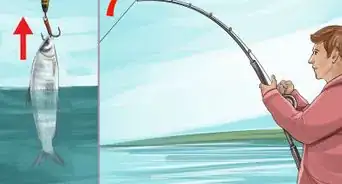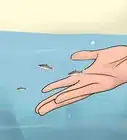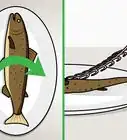This article was co-authored by wikiHow Staff. Our trained team of editors and researchers validate articles for accuracy and comprehensiveness. wikiHow's Content Management Team carefully monitors the work from our editorial staff to ensure that each article is backed by trusted research and meets our high quality standards.
This article has been viewed 71,080 times.
Learn more...
Sometimes the best way to catch a fish is with a fish. A bait fish that is caught from the shallows of a nearby bank will move and respond in a manner that the local bass are used to chasing, whereas a tank-raised shiner might not attract the same attention from the big fish because it is not used to having to dart away from predators. Learning how to catch shiners will not only draw in a bigger catch but also save you the cost of purchasing bait as well.
Steps
Catching with Traps
Using a trap to catch shiners is the most stress-free method for both you and the baitfish.
-
1Search the shallows. Concentrate on shaded areas around docks, overhanging trees, and vegetation. Avoid very dense vegetation, which will make spotting fish more difficult. Look for active shiners zipping along just below the surface of the water. Find a strategic area to set your trap.[1]
-
2Chum the water if necessary. Lure the shiners out of dense vegetation and deeper waters. Tear bread into fairly large chunks that are big enough for several shiners to feed on at once, which will help reveal how many are in the immediate area.Advertisement
-
3Bait and set your trap. Use bread or crackers to lure shiners inside. Place the trap in shallow water. If the current's strong, anchor it with a few rocks inside or secure it by tying a line.[2]
-
4Collect your catch. Wait for shiners to collect inside. Then, if possible, keep your trap partially submerged in the water when you open it to remove your shiners; this way your fish will remain relatively stress-free. Transfer them to storage as quickly as possible so they remain as healthy as possible.
Catching with a Seine Net
Seine nets are another easy way to catch several shiners at once while keeping them relatively free of stress.
-
1Bring at least one partner. Using a seine net is a two-person job at minimum.[3] To make collecting the fish at the end even easier, bring a third partner or more. Make sure everyone’s fine with getting wet, since you’ll all be in the water.
-
2Search the shallows. Find a place close to shore where the riverbed is fairly uniform and even. Stick to the shallows, in water low enough to keep your waist clear while wading. Avoid heavy currents that may knock you off balance or scatter fish.
-
3Hold the net upright. Have one person hold either end. Spread out until the net is fully extended between the two of you. If your net has lead weights and/or floats, make sure the weights run along the bottom and the floats along the top.[4]
-
4Designate one person to stick close to shore. Have them stand in shallow water only a few strides out from dry land. Be sure they have enough distance on either side of them for the net to remain fully extended when parallel to the shoreline. Instruct this person to stand in place.[5]
-
5Designate the second person to wade out into the water. Keeping the net tight and fully extended, have them drag the net through the water in a 180º sweep around the first person, who remains close to shore, fixed in place, as a pivot. Be sure the bottom of the net drags along the riverbed so no shiners escape underneath it. Trap the shiners between the net and the shoreline as the second person returns toward land.[6]
-
6Collect the shiners. Cut off any possible exit by bringing both ends of the net onto dry land or closer to it. If you’ve brought a third partner along, have them scoop the shiners out of the water with a teardrop net. If there’s only two of you, bring the seine net’s two ends close enough together for one person to hold each while the other scoops the shiners out of the water.
Catching with a Cast Net
Cast nets are a one-person operation and can be used in both shallow and deeper water. It’s less stressful on the fish than using a rod and reel, but casting a net perfectly so that it lands entirely spread out on the water’s surface requires some finesse and may take a lot more practice than operating a seine net. Practice your technique beforehand, either on land or in a body of water separate from where you intend to fish, so that you don’t scare away your shiners with too many bungled casts.[7]
-
1Pick a spot to cast. Keep clear of dense vegetation or any objects that may snag or otherwise interfere with your net. Search the shallows for active shiners, or scan the surface of deeper waters for bubbles, boils, and other signs of activity just below the surface. Chum deeper waters with bread bits. Continue to chum for around 15 minutes before casting in order to attract as many shiners as possible.[8]
- When casting in shallow water, use a smaller-sized net, around 5’ in diameter.[9]
-
2Cast your net. Throw it so that it spreads out on its own before it lands on the water. Practice your technique before using your net to fish.[10] Multiple techniques exist, but one of the simplest is to:
- Coil the throw-line in your favored hand. Then, with your other hand, hold the net up, fully extended, with the weights resting on the ground. Next, clutch the net in your favored hand at waist-height.[11]
- Raise your favored hand. Hold the net up as though you were showing off your bicep. With your free hand, pinch one edge of the net’s weighted bottom between your thumb and index finger, picking a spot directly below your raised hand’s thumb.[12]
- Extend your favored arm. Hold it straight out to your side. Draw your other arm up to the center of your chest, allowing the bottom of the net to open by a quarter.[13]
- Face the target area. Rotate your body backward by 90º on your favored side. Then rotate back to your original position, casting your net high as you swing through, while keeping hold of the throw-line.[14]
-
3Close the net. Allow the weights to sink in the water for a few seconds, then pull the rope tight to close the net. Be sure to close the net before the weights reach the water’s bed. Avoid tangling the net in objects resting on the bottom.[15]
-
4Land your shiners. Haul the net in by its rope, hand-over-fist. Once you hoist your catch out of the water, open the net and transfer the fish to storage. Move quickly to keep your catch as healthy as possible.
Catching with a Rod and Line
Using a rod and line to catch shiners is more time-consuming, since you have to catch each fish individually. It’s also more likely to tire and stress the fish, which may make your live bait less effective later on if you intend on using it to catch larger fish on the same day. But if you just love to fish, go for it.
-
1Pick a spot to fish. Search shallow, shaded water for active shiners.[16] Avoid dense vegetation that may foul lines. In deeper water, scan the surface for bubbles, boils, and other disturbances that indicate activity below the surface. If necessary, hum the surface with a small amount of bread to lure shiners out into the open or up from the deep[17]
-
2Bait your hook. Use a small treble hook to avoid injuring the fish. Bait the hook with balls of bread. Lower your bait into the water, keeping it on the surface.[18]
-
3Reel your catch in. Once you feel a bite, wait a moment or two to give the shiner a chance to continue feeding in case it hasn’t actually hooked itself yet. Then reel your line back in gently until the line grows tight. Keep your motions smooth and gentle; avoid jerking the rod too violently and losing the shiner before it’s fully hooked.
-
4Land your shiner. Hoist it out of the water. Keep a firm grip on your shiner as you unhook it so it doesn’t wriggle free. Be careful to not squeeze it so hard that you injure it.[19]
Storing Your Catch
-
1Keep your shiners comfortable. Once caught, place them immediately into an aerated live-well, a flow-through bait bucket, or a cooler with an aerator. Keep them well oxygenated to avoid loss. Minimize their stress as much as possible so they recuperate quickly and act normally when used as live bait.
-
2Maintain water temperature. Use an accurate thermometer. Keep water under 60ºF. For short-term, same-day storage, add ice to your cooler or bait bucket if it’s a particularly hot day. For long-term storage, invest in a refrigerated, insulated tank or a water circulation system to minimize losses.[20]
-
3Clean your tank. For long-term storage, avoid losses through disease by cleaning your tank regularly. Paint your tank’s interior with pool and tank paints to seal the surface and minimize disease.[21]
Community Q&A
-
QuestionCan you eat a shiner?
 Community AnswerYes, but you have to make sure you cook them just right so bacteria dose not survive.
Community AnswerYes, but you have to make sure you cook them just right so bacteria dose not survive. -
QuestionWhat food to attract shiners?
 YOGESH DHATRAKCommunity AnswerChumming with oatmeal, casting the flakes over shallow, weedy flats will bring schools of golden shiners into the area and get them feeding.
YOGESH DHATRAKCommunity AnswerChumming with oatmeal, casting the flakes over shallow, weedy flats will bring schools of golden shiners into the area and get them feeding.
Things You'll Need
- Bait fish traps
- Seine net
- Cast net
- Bait
- Small hooks
- Bait tank or cooler
Warnings
- Be cautious when entering the water. Wear proper boots to protect your feet. Avoid large rocks and other objects that may be covered in slick algae. Pay attention to currents and rainfall, which may cause the river to swell quickly.⧼thumbs_response⧽
References
- ↑ http://www.bassfishingandcatching.com/catching-live-bait.html
- ↑ http://www.bassfishingandcatching.com/catching-live-bait.html
- ↑ http://www.bassfishingandcatching.com/catching-live-bait.html
- ↑ http://www.bassfishingandcatching.com/catching-live-bait.html
- ↑ http://www.bassfishingandcatching.com/catching-live-bait.html
- ↑ http://www.bassfishingandcatching.com/catching-live-bait.html
- ↑ http://myfwc.com/media/2705431/CITFISH_35_RGB.pdf
- ↑ http://myfwc.com/media/2705431/CITFISH_35_RGB.pdf
- ↑ http://myfwc.com/media/2705431/CITFISH_35_RGB.pdf
- ↑ http://www.bassfishingandcatching.com/catching-live-bait.html
- ↑ http://www.castnetworld.com/cast-net-throwing.html
- ↑ http://www.castnetworld.com/cast-net-throwing.html
- ↑ http://www.castnetworld.com/cast-net-throwing.html
- ↑ http://www.castnetworld.com/cast-net-throwing.html
- ↑ http://myfwc.com/media/2705431/CITFISH_35_RGB.pdf
- ↑ http://www.bassfishingandcatching.com/catching-live-bait.html
- ↑ http://www.landbigfish.com/articles/default.cfm?ID=2549
- ↑ http://www.landbigfish.com/articles/default.cfm?ID=2549
- ↑ http://www.landbigfish.com/articles/default.cfm?ID=2549
- ↑ http://www.wholesalebait.com/keeplivebait.php
- ↑ http://www.wholesalebait.com/keeplivebait.php
- ↑ http://www.landbigfish.com/articles/default.cfm?ID=2549
- ↑ http://myfwc.com/media/2705431/CITFISH_35_RGB.pdf
- ↑ http://www.bassfishingandcatching.com/catching-live-bait.html
About This Article
The easiest way to catch shiners is to bait a trap with bread or crackers and set it in shallow water. Once the shiners are trapped inside, transfer them immediately to a bait bucket filled with clean water so they remain as healthy as possible. Alternatively, you can fish for the shiners by baiting a small treble hook with a ball of bread. However, be aware that this method is more time-consuming and more likely to stress the fish, so make sure you’re able to efficiently remove the fish from the hook before using this method. To learn more, including how to catch shiners with a cast net or a seine net, scroll down.
